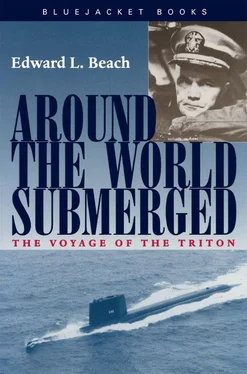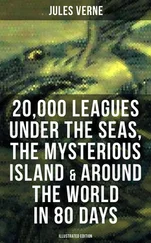There was really nothing unusual in these “discoveries” which we were making; submariners have known and applied the principles for years. But there is no substitute for experience, which opens many new avenues of inquiry.
For example, there was the question whether gradual oxygen reduction each day for a prolonged period would have any damaging consequences on us. The effects of depriving the human body of oxygen all at once to an excessive degree are well known. But what about minor deprivation for many days? No observable deleterious effects have been noted, but many highly qualified medical people have recently been devoting considerable research to this question. The problem ranges from the physical to the psychological, from an environment of oxygen deficiency to one in which the entire atmosphere is mechanically controlled and stabilized at some optimum point.
From the Log:
The Medical Research Laboratory in New London has been pursuing this particular project for a long time, the first announced test being Operation Hideout in the mothballed submarine Haddock in 1953. Doctors Ben Weybrew and Jim Stark have been discussing the sealed-atmosphere test for several days, and finally have proposed a procedure. We will remain sealed for approximately 2 weeks, running various physical and psychological tests among selected volunteers from the crew. Somewhere during the mid-point of this period we will put out the smoking lamp for an extended time. Careful checking of all factors will continue for several more days before terminating the study.
The purpose of the no-smoking test was partly psychological, but there was a question of atmospheric research, too. Smoking, nuclear submariners had discovered, was their only source of carbon monoxide. In a completely sealed atmosphere, accumulation of carbon monoxide could not be permitted because of its deadly brain-damaging tendency. Expensive equipment had been devised and installed to convert it into carbon dioxide, so that it might be “scrubbed” from our atmosphere along with the carbon dioxide exhaled from our lungs.
One of the questions raised was whether or not this equipment was worth the cost; or whether it would be better to prohibit smoking in a completely sealed atmosphere, instead of going to the added expense and trouble of installing the carbon-monoxide removal apparatus purely because of the psychological satisfaction that some men got out of smoking. All this, of course, has a direct bearing on the endurance of submarines at sea—their ability to cope with the various problems they would undoubtedly encounter, and the efficiency with which they might be expected to operate under various severe conditions. The data that we were helping to gather would become available to our first space pioneers also.
Everyone on board was determined to go through with the test in good heart and spirit, but as the dread day for putting out the smoking lamp approached, various reactions were noticeable among crew members. The nonsmokers were lording it over the others, describing with great relish how the test would have no effect whatsoever on them, and there was an aura of apprehension among the habitual smokers. Even before we put the smoking lamp out, the witticisms had an edge to them, and some of the protestations that “smoking don’t mean that much to me” developed a noticeably defensive tinge.
One saving feature in the eyes of many was the fact that both doctors on board, Commander Jim Stark, who dabbled in psychology, and Dr. Ben Weybrew, professional psychologist attached to the Medical Research Laboratory, were themselves inveterate smokers. Weybrew created quite a stir, therefore, the evening before the test was scheduled to begin, when he casually tossed his pipe into the garbage ejection chute. He, at least, was ready to make his sacrifice for science, and it was said that he whistled happily as he prepared the charts and the graphs he would draw as a result of our sufferings.
One thing we did notice as soon as we sealed up the ship: maintaining our atmosphere at a common standard level of oxygen content was a far more comfortable way to exist. Among other things, the air conditioners had less work to do; once the humidity was brought to the optimum level, it was easy to maintain. Previously, and by contrast, the fresh air drawn in from just a foot or two above the surface of the tropical seas was extremely humid and salty, dampening the entire ship for a few hours until the air-conditioning machinery had caught up with it again. To illustrate a second advantage: perhaps I personally had become accustomed to the daily deprivation of oxygen, or perhaps I had simply been unaware of my reduced efficiency. At any rate, I found myself more alert, more alive, and less tired when breathing the artificial atmosphere than when we were taking daily snorts of fresh air.
Everyone on board, I believe, had a somewhat similar reaction. We settled down quickly to the pleasantest period of the entire trip and, deeply submerged, crossed the Indian Ocean without physical contact with the outside in any way.
The Indian Ocean, by the way, is to the US sailor one of the least-known oceans. Yet it was one of the better-known waters of Renaissance days. According to the chart, it is uniformly deep, its bottom scarred by relatively few of the peaks and valleys familiar to the Atlantic and Pacific. In color, the water seems somewhat bluer, more transparent, with less marine life and less natural or artificial flotsam and jetsam.
During the war, the southern part of the Indian Ocean was especially active with German surface raiders and the British task forces set out to intercept them; and there were German, Japanese, British, and Dutch submarines on patrol in the area as well. So far as America is concerned, however, it is one of the oceans we still have to discover. Now that knowledge of the sea is of greater importance to our country than ever before, it is probably time we learned some of the intimate details of this great and unexplored body of water.
Monday, 11 April 1960 A message from ComSubPac relays information from ComSubLant announcing prospective promotion of Chief Petty Officers Bennett, Blair, Hampson, Hardman and Loveland to the rank of Ensign, and of the following First-Class Petty Officers to the rate of Chief Petty Officer: Hoke, Meaders, Lehman, Mather, Pion, Stott, Bloomingdale, Flasco, Fickel and Tambling. There is jubilation among the lucky advancement winners and good sportsmanship among the others. But this can’t be the entire promotion list, since examinations for all rates down to Third Class were held before departure. More information should be forthcoming soon. Five Ensigns and ten Chief Petty Officers is a tremendous haul for any single ship, particularly one with a crew of only 159 enlisted men. It is a tribute to the overall capability of our crew, and to the hard effort of the men themselves. The fact that their tests were taken during an extremely heavy watch-standing schedule, to which was added strenuous overtime preparation for an unusual cruise, adds to the accomplishment.
The opportunity for hazing some of the lucky ones is too good to be missed. One by one they are called before me to be asked, in a grave voice, “What have you done to cause ComSubLant to send a message to us about your actions?” The look of incredulity on the faces of the first ones to arrive was real enough, but all ships have a sort of extra-sensory communication among the crew, and I doubt if the last few were particularly perturbed by my feigned severity.
Tuesday, 12 April 1960 Seventh babygram—sixth girl, 9 1bs., born 8 April; father, Bruce F. Gaudet, IC3. Both mother and baby fine. Poor Gaudet had been getting a little worried, but he feels fine now.
Six days a week all during our cruise, the Triton Eagle had faithfully come out in the early morning hours, composed directly on the duplicating machine paper by editor in chief Harold J. Marley and laboriously run off on the printing machine, with the ship’s office swept up afterward, by Audley R. Wilson, Radarman First Class, who comprised the entire staff of the paper outside of the editor. Except for one memorable day when Editor Marley took all his news from a three-year-old edition of the New York Times (detected by very few people, surprisingly), we had managed to get up-to-date news. Every day or so I managed to come up with a column of some kind for the paper—either “The Skipper’s Corner” or another, which I fondly hoped was a humor column, supposedly written by an unidentified person named Buck. Buck was an unregenerated sailor, butt of all jokes, apt only in hiding from work and the “OM” (myself, the “Old Man”). Theoretically, nobody knew that Buck was the “OM” himself.
Читать дальше












